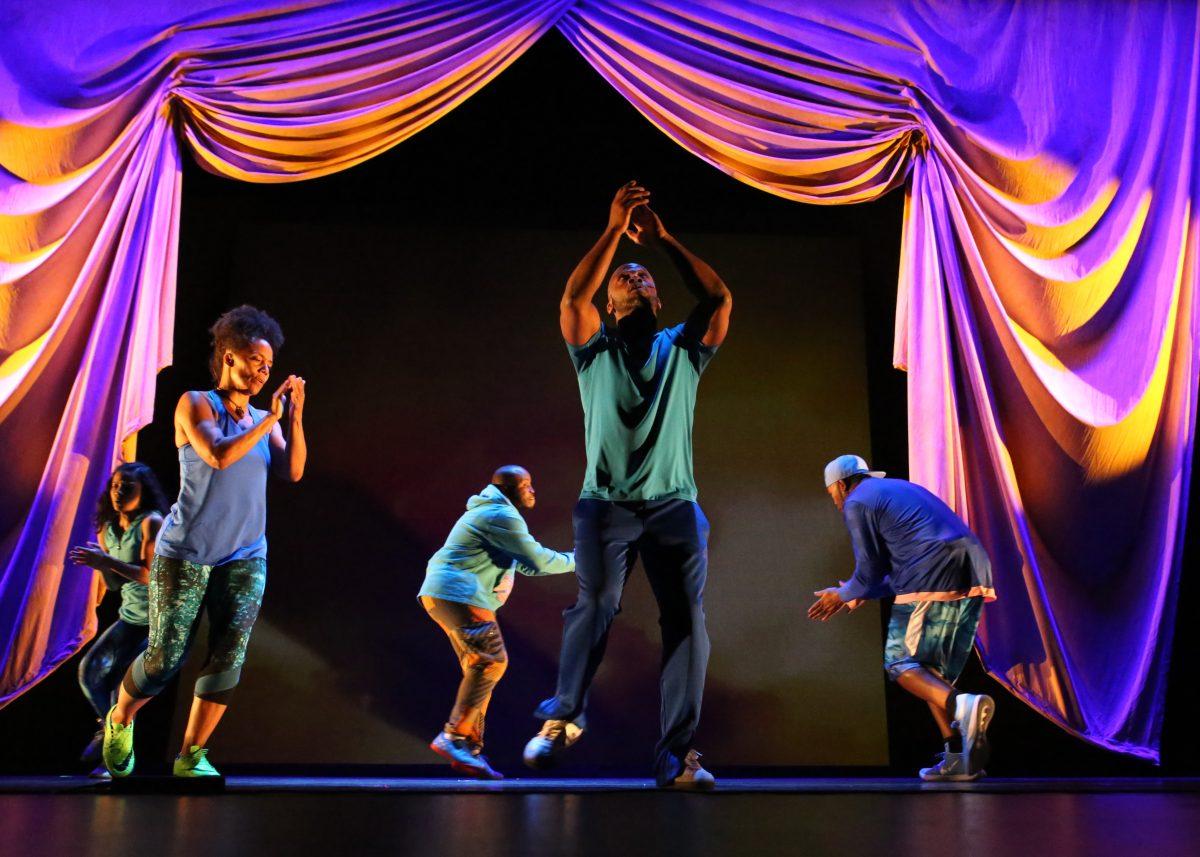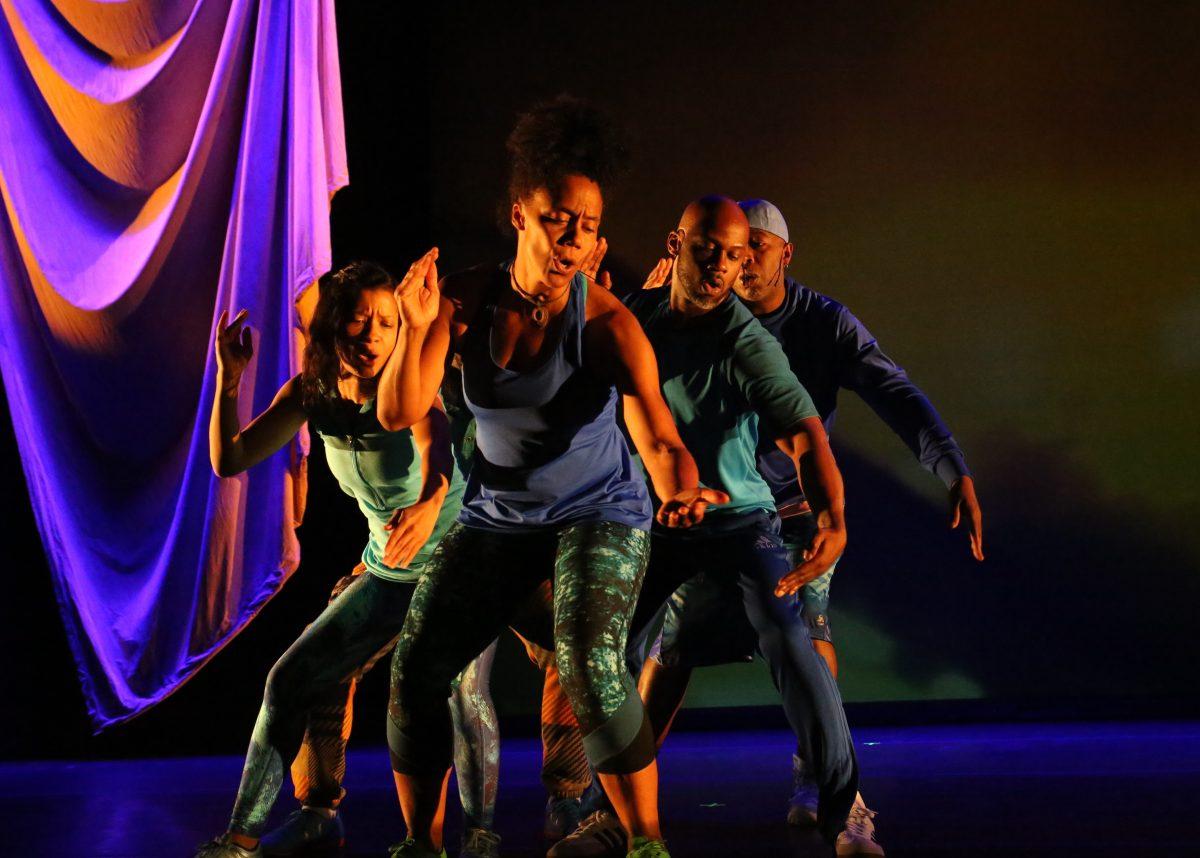Captivating images showing the civil rights movement and Trayvon Martin in a 7/11 store flashed, sounds from the 2014 Brazil World Cup rang out behind passionate monologues, and an all-black cast danced and sang soulful blues to the audience. They were experiencing nothing short of a beautiful and mesmerizing intersection of art, sport and modern life through the eyes of the African-American experience.
Through incessant dance and poetry, audiences in Stewart Theatre on Wednesday night were taken by artist and actor Marc Bamuthi Joseph and the members of The Living Word Project theatre company in “/peh-LO-tah/,” a 70-minute journey of theatre and dance with a kick. A soccer kick, to be exact.
Darkness in the theatre was struck by a spotlight shining on Joseph, sporting athletic wear, repeatedly whispering “Give me the ball” in Spanish, “Dame la pelota,” as he performed soccer trick techniques over a stationary ball, breathing loudly and rhythmically, providing the background and recurring theme of this production.
“Everything I learned about the life of immigrants was that they were playing without a ball,” Joseph said.
He presented this analogy while decked out in a Brazilian “futbol” jersey. Engaging in a unique performance centered around storytelling, Joseph took audiences through his life as a soccer player, as a father and as a black person in America.
The central topic of systematic oppression, and a liberation from it, was communicated through song, dance and film as short videos played portraying black insights and thoughts, as Joseph told stories of his past and the members of the Living Word Project sang or danced next to him, all creating rhetorical grounds that augmented the message of a harsh subject matter that must be heard.
Audiences were treated to “amusica brasileira” as Joseph engaged in monologues and spoken word poetry describing the 2014 Brazil World Cup, and how soccer was a uniting force for the world, a space in which equality momentarily existed and nations could convene for the common cause of putting the ball in net.
In this multisensory performance, the rhetorical appeal to emotion was strong, containing different matters, such as Joseph describing having to tell his son that he must look out because he is being hunted by a “slow stroll patrol,” as a young black male, and the invoking of African-Americans dead at the hands of police and of American school shootings.
The theme of soccer echoed throughout as the actors exercised soccer techniques and movements in perfect unison, breaking out into dance and song followed immediately after by fervent spoken word poetry filled with words that exert pain as they are spoken.
Francine Ott, dance lecturer and director of NC State dance company Panoramic Dance Project, was in attendance and spoke on how the performance resonated with her.
“It really touched base and I really connected with it in terms of the work that I like to do focusing on humanity, but also Black Lives Matter and social justice and social dance,” Ott said. “Just being able to see that in the body, I really like how he also connected it to the game of soccer.”
The performance demonstrated different members of the group who represented different positions on the soccer field, and each position dealt with a different topic, all relevant to the rhetoric of social justice.
Images of soccer displayed with the descriptions such as, “The center forward explains inequity,” in which Amara Tabor-Smith highlighted pay inequity of women in soccer. “The defender explains why Americans suck at soccer,” prompted an argument that Americans were only good at basketball because it involved less teamwork and more focus on a strong player, as opposed to soccer, where teams are only as strong as their weakest player and equity is needed, something America struggles with exercising.
This critique on American society (and soccer performance) reinforced the strong political commentary. This reached over to gun control through “The goalkeeper portrays why the NRA can go f— itself,” containing a brazen exposition of gun violence.
A Q&A after the performance allowed for The Living Word Project to speak further and unpack what the performance contained in terms of theory and political content. Joseph elaborated on the “Dame la pelota” analogy.
In the ongoing performance of dance and poetry and the continued metaphorical request for the soccer ball, Joseph expressed that the events of oppression like the murder of unarmed African-Americans were the “scripts for the performance of outrage.”
“Moving without a ball is the immigrant story,” Joseph said. “It kind of goes back to this thing about who’s at center. If you are not in possession, how do you maintain relevance, how do you sustain yourself? Those questions underscore an immigrant’s path and I would extend this spectrum to anybody without possession.”
Tabor-Smith stressed the importance of the saying that “the artists are the first responders” to the trauma and crises of the oppressed, a calling to which The Living Word Project carried out to the fullest, most artistic extent in “/peh-LO-tah/.”
Members of The Living World Project tackle social issues through dance, poetry and soccer in Stewart Theatre on March, 28, 2018.














